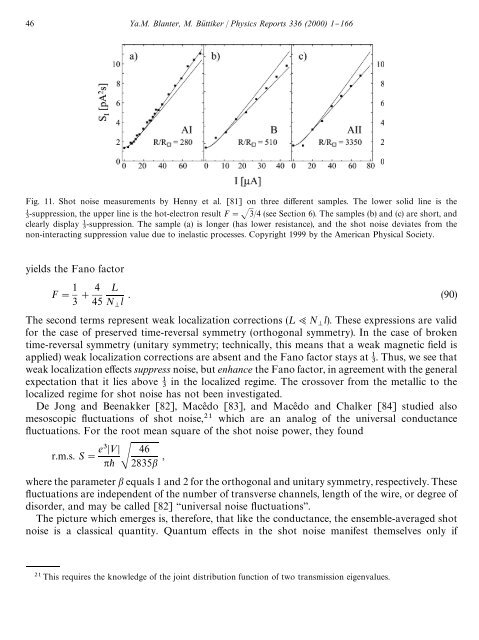shot noise in mesoscopic conductors - Low Temperature Laboratory
shot noise in mesoscopic conductors - Low Temperature Laboratory
shot noise in mesoscopic conductors - Low Temperature Laboratory
Create successful ePaper yourself
Turn your PDF publications into a flip-book with our unique Google optimized e-Paper software.
46 Ya.M. Blanter, M. Bu( ttiker / Physics Reports 336 (2000) 1}166<br />
Fig. 11. Shot <strong>noise</strong> measurements by Henny et al. [81] on three di!erent samples. The lower solid l<strong>in</strong>e is the<br />
-suppression,<br />
the upper l<strong>in</strong>e is the hot-electron result F"3/4 (see Section 6). The samples (b) and (c) are short, and<br />
<br />
clearly display -suppression. The sample (a) is longer (has lower resistance), and the <strong>shot</strong> <strong>noise</strong> deviates from the<br />
<br />
non-<strong>in</strong>teract<strong>in</strong>g suppression value due to <strong>in</strong>elastic processes. Copyright 1999 by the American Physical Society.<br />
yields the Fano factor<br />
F" 1 4 ¸<br />
# . (90)<br />
3 45 N l<br />
<br />
The second terms represent weak localization corrections (¸;N l). These expressions are valid<br />
<br />
for the case of preserved time-reversal symmetry (orthogonal symmetry). In the case of broken<br />
time-reversal symmetry (unitary symmetry; technically, this means that a weak magnetic "eld is<br />
applied) weak localization corrections are absent and the Fano factor stays at . Thus, we see that<br />
<br />
weak localization e!ects suppress <strong>noise</strong>, but enhance the Fano factor, <strong>in</strong> agreement with the general<br />
expectation that it lies above <strong>in</strong> the localized regime. The crossover from the metallic to the<br />
<br />
localized regime for <strong>shot</strong> <strong>noise</strong> has not been <strong>in</strong>vestigated.<br />
De Jong and Beenakker [82], Mace( do [83], and Mace( do and Chalker [84] studied also<br />
<strong>mesoscopic</strong> #uctuations of <strong>shot</strong> <strong>noise</strong>, which are an analog of the universal conductance<br />
#uctuations. For the root mean square of the <strong>shot</strong> <strong>noise</strong> power, they found<br />
r.m.s. S" e<<br />
46<br />
2835 ,<br />
where the parameter equals 1 and 2 for the orthogonal and unitary symmetry, respectively. These<br />
#uctuations are <strong>in</strong>dependent of the number of transverse channels, length of the wire, or degree of<br />
disorder, and may be called [82] `universal <strong>noise</strong> #uctuationsa.<br />
The picture which emerges is, therefore, that like the conductance, the ensemble-averaged <strong>shot</strong><br />
<strong>noise</strong> is a classical quantity. Quantum e!ects <strong>in</strong> the <strong>shot</strong> <strong>noise</strong> manifest themselves only if<br />
This requires the knowledge of the jo<strong>in</strong>t distribution function of two transmission eigenvalues.
















